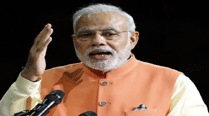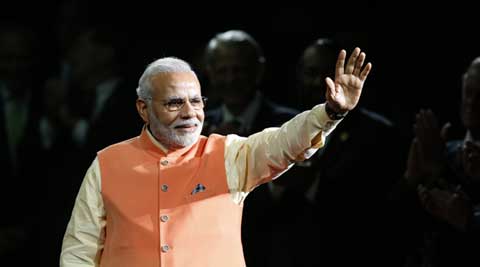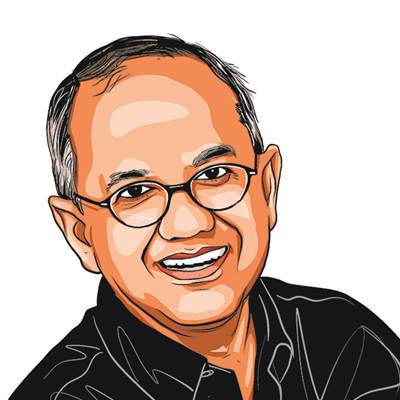Opinion Only if they break free of the past
India-US rhetoric is promising. Now we need policy shifts in India and concessions from America

 Modi’s visit has generated substantial hope in both capitals about the reinvigoration of the US-India relationship. (Source: PTI)
Modi’s visit has generated substantial hope in both capitals about the reinvigoration of the US-India relationship. (Source: PTI)
Prime Minister Narendra Modi’s maiden visit to the US in his present capacity has just come to a close. As widely reported, his performance at New York’s Madison Square Garden was nothing short of an extravaganza. Despite a few stray demonstrators outside, he managed to bring the crowd to its feet amidst dance, music and a dazzling array of lights. Subsequently, his visit to Washington, DC has also yielded a striking joint communiqué that is simply vaulting in its scope and ambition. It sweeps across a range of possible areas of cooperation, extending from the development of civilian nuclear power to global counterterrorism. It also reiterates the common interest of both states in having India as a member of a reformed UN Security Council.
These goals, while lofty, are laudable and even desirable. However, what remains unknown are the likely strategies that the two sides will need to realise even a fraction of this vast agenda. Past communiqués have also been known for emphasising common democratic values, have expressed a desire for expanding the band of cooperation and have highlighted the need to meet various global challenges.
Suggesting that this joint statement amounts to little more than empty rhetoric would be both churlish and shortsighted. It would be harsh because it is important for national leaders to spell out defining visions, even if their realisation proves hard. It would also be ill-considered to dismiss those sentiments because a number of the goals that have been outlined are indeed worthwhile and desirable.
To achieve the levels of cooperation that have been delineated will require adroit diplomacy on the part of both sides. At the outset, little will be accomplished if various constituencies, especially in India, continue to dwell inordinately on the past. It is well known that the US and India, apart from fleeting moments, were at odds during the Cold War. These memories continue to haunt many within India’s elite circles. These lingering doubts focus mostly on the reliability of the US, its long dalliance with Pakistan and its uneven relationship with China. Despite their continuing presence, it is nevertheless important to recognise that both states now occupy markedly different positions in the emerging global order. Consequently, the past is not necessarily the most reliable guide to the future. Instead, a clear-eyed assessment of the present global circumstances suggests that the two states may well not remain prisoners of the past.
What are some of these changed circumstances? Today, the US and India, not to mention the states of East and Southeast Asia, confront the reality of a rising and potentially aggressive China. The border incidents in Ladakh during President Xi Jinping’s recent visit were a stark reminder that despite loud professions of friendship and amity, Sino-Indian relations remain fraught. The existence of these bilateral tensions does not mean that India should join hands with the US in a containment strategy of China. Quite frankly, few policymakers in Washington would even advocate such an approach in any case. However, that should not preclude a more robust set of strategic ties with the US. The American “rebalancing” strategy has been thrown a bit off-track with recent developments in Ukraine and in the Arab Middle East. However, a great power of the order of the US has the capacity to cope with multiple crises in the medium to longer term. So, it would be premature to argue that the pivot to Asia has no future. Instead, it may well be worth New Delhi’s while to pursue a process of consultation and dialogue on the subject with Washington. Such low-key diplomatic engagement could actually provide India with a margin of reassurance and safety against a possibly aggressive China.
Also close to home is the vital matter of the future of Afghanistan. The country, after a long and contentious electoral process, appears to have settled on a power-sharing agreement. However, it is far from out of the woods as the Taliban and its sponsors across the border seem intent on destabilising it. Once again, despite the past US tendency of relying on Pakistan, Delhi now has an opportunity to play an expanded role in stabilising Afghanistan. To effectively play such a role, it needs to press forward a dialogue with the US. With a belated American recognition of India’s substantial developmental thrust, the moment is ripe to boost the Indian presence in Kabul and elsewhere. Deft Indian diplomacy can help undermine the base Pakistani canard that India seeks to encircle it through an expanded role.
These strategic concerns, of course, should be at the forefront of conversations after the prime minister’s visit. However, the future of the relationship is also likely to turn quite significantly on more fruitful economic and commercial ties. The differences that have cropped up in recent years are well known. The task before Delhi is to start addressing some of them with dispatch. To that end, the Modi government made two important gestures even before his visit to the US. One was the decision to dramatically expand the capacity of the patent office in India. The other involved the decontrol of some drug prices. The latter was, without a doubt, a costly signal, as it has already proven unpopular at home. Other areas of American concern, ranging from the expansion of multi-brand retail to retroactive taxation, remain.
Modi can indicate his willingness to start dealing with these issues after forging a domestic consensus. Simultaneously, he can also insist that such shifts in Indian policies will need to elicit suitable American concessions. Such a reciprocal approach could prove to be a sound basis for greater cooperation in the economic arena.
Modi’s visit has generated substantial hope in both capitals about the reinvigoration of the US-India relationship. The task before their respective policymakers and diplomats is to ensure that these prospects are not dashed owing to the fears of the past and the exigencies of the present.
The writer holds the Rabindranath Tagore Chair in Indian Cultures and Civilisations at Indiana University, Bloomington, US



